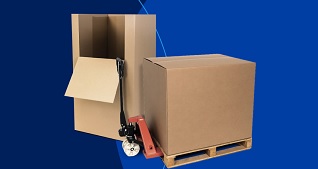Shipping heavy items, whether for personal or business purposes, can be a complex task requiring careful planning and execution. From selecting the right shipping method and carrier to ensuring the safety and integrity of the item, several factors need to be considered. The following guide provides detailed insights and practical tips for successfully shipping heavy items.
Preparing the Item for Shipment
Proper preparation is crucial to ensure the item arrives safely at its destination:
- Disassemble When Possible: If the item can be safely disassembled, do so to make it more manageable and to reduce the risk of damage. Keep small parts in labeled bags.
- Clean and Protect: Clean the item to prevent any dirt or debris from causing damage while the item is in transit. Use protective materials (bubble wrap, foam padding, and moving blankets) to cushion the item.
- Choose the Right Packaging: Select sturdy packaging materials. Heavy-duty boxes, wooden crates, or pallets are often necessary for heavy items. Ensure the packaging is durable and can withstand the item’s weight. Being able to select the proper packaging and effectively design your own custom stickers will not only protect and present your product but also serve as a powerful tool for creating positive customer experiences and standing out in the market.
- Secure the Item: Use straps, packing tape, and fillers to secure the item within its packaging, preventing movement that could cause damage.
Selecting the Appropriate Shipping Method
Choosing the right shipping method is essential for cost efficiency and safety:
- Freight Shipping: For very heavy items, freight shipping is often the best option. This includes options like less-than-truckload (LTL) and full truckload (FTL) services. LTL is suitable for smaller loads, while FTL is for larger shipments that occupy an entire truck.
- Courier Services: Some courier companies handle heavy items but may have weight and size limits. Compare rates and services from different couriers to find the best option. If you want to ship your motorbike, you will need to research options beforehand.
- Air Freight: For urgent shipments, air freight can be used, although it is typically more expensive than ground or sea shipping.
- Sea Freight: For international shipments, sea freight is cost-effective but slower. Consider this option for non-urgent, heavy items.
Calculating Shipping Costs
Understanding the cost factors can help in budgeting and selecting the right service:
- Weight and Dimensions: Shipping costs are primarily based on the weight and dimensions of the item. Measure and weigh the package accurately.
- Distance: The shipping distance impacts the cost. Longer distances generally result in higher fees.
- Shipping Speed: Expedited shipping costs more than standard shipping. Determine the urgency of the shipment to choose the appropriate speed.
- Additional Services: Services such as liftgate delivery, inside delivery, and insurance add to the cost. Assess your needs to decide which additional services are necessary.
Labeling and Documentation
Proper labeling and documentation are critical for smooth shipping:
- Shipping Labels: Clearly label the package with the destination address, return address, and any special handling instructions.
- Bill of Lading (BOL): For freight shipments, a BOL is required. This document details the shipment’s contents, destination, and terms of transport.
- Customs Documentation: For international shipments, complete all necessary customs forms and declarations to avoid delays or issues at borders.
Ensuring Safety and Compliance
Following safety protocols and compliance regulations is vital:
- Weight Limits: Adhere to weight limits set by shipping carriers to avoid penalties or shipment refusals.
- Hazardous Materials: If the item is classified as hazardous, comply with all regulations for packaging, labeling, and documentation.
- Insurance: Purchase insurance to cover potential damage or loss during transit. Evaluate the item’s value to determine the appropriate level of coverage.
Tracking and Monitoring
Keeping track of your shipment ensures peace of mind and timely delivery:
- Tracking Services: Use tracking services provided by the shipping carrier to monitor the shipment’s progress. Many carriers offer real-time tracking updates.
- Contact Information: Provide accurate contact information to the shipping carrier to facilitate communication in case of issues or delays.
- Check for Updates: Regularly check for updates on the shipment’s status and be proactive in addressing any problems that arise.
Receiving the Shipment
Properly receiving the shipment is as important as sending it:
- Inspect on Arrival: Inspect the item upon arrival for any damage. Document any issues with photos and notes.
- Report Issues: Report any damage or discrepancies to the shipping carrier immediately to initiate a claims process if necessary.
- Assemble and Test: If the item was disassembled, reassemble it and test its functionality to ensure it arrived in working condition.
Conclusion
Shipping heavy items requires meticulous planning and attention to detail. By following the steps outlined in this guide—preparing the item properly, selecting the right shipping method, calculating costs accurately, ensuring proper labeling and documentation, adhering to safety and compliance standards, tracking the shipment, and carefully receiving the package—you can ensure a smooth and successful shipping experience. Whether for personal or business purposes, these best practices will help you manage the complexities of shipping heavy items effectively.

